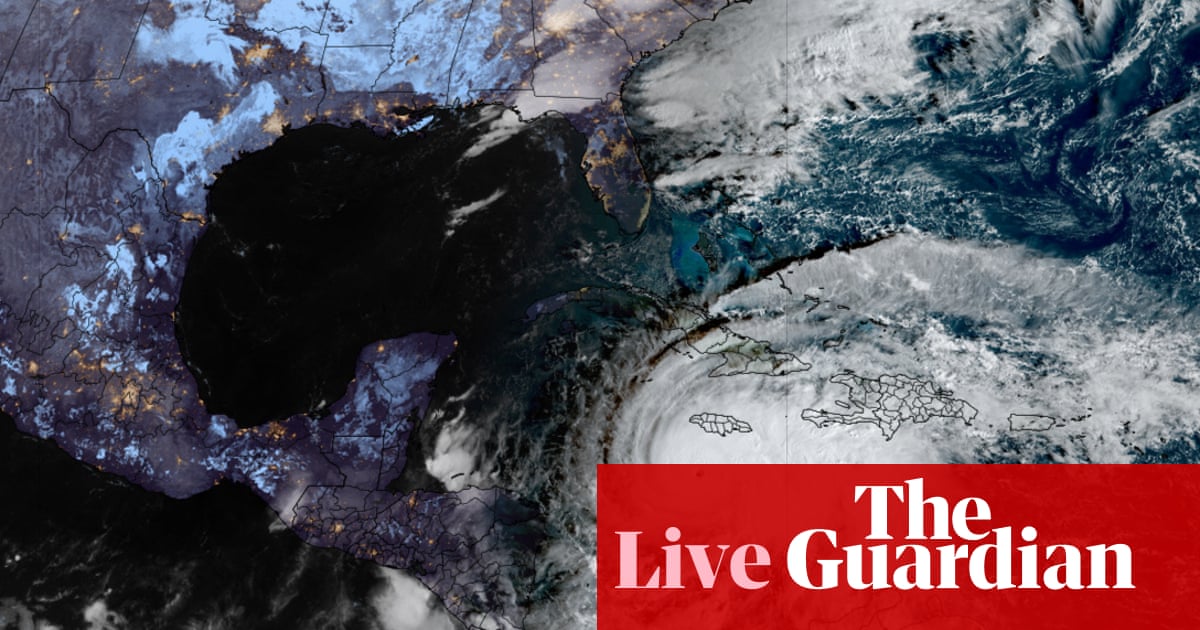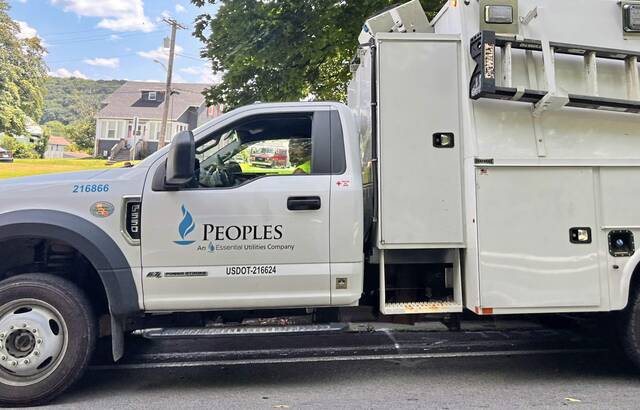Hurricane Melissa has ‘ingredients to be a catastrophic storm’, expert warns
Liz Stephens, professor in climate risks and resilience at University of Reading, said:
Having now intensified to Category 5, slow-moving Hurricane Melissa has all the ingredients to be a catastrophic storm, with devastating storm-surge, extreme winds and unusually high rainfall accumulations.
“Communities in Jamaica will need to prepare for potentially unimaginable impacts, and with climate change fuelling stronger storms with higher rainfall totals, this is a stark example for other countries as to what may be in store for them,” Stephens added.
Key events
Here is an updated satellite image of the hurricane’s possible route:
Hurricane Melissa has ‘ingredients to be a catastrophic storm’, expert warns
Liz Stephens, professor in climate risks and resilience at University of Reading, said:
Having now intensified to Category 5, slow-moving Hurricane Melissa has all the ingredients to be a catastrophic storm, with devastating storm-surge, extreme winds and unusually high rainfall accumulations.
“Communities in Jamaica will need to prepare for potentially unimaginable impacts, and with climate change fuelling stronger storms with higher rainfall totals, this is a stark example for other countries as to what may be in store for them,” Stephens added.
As we mentioned in an earlier post, category 5 is the highest category on the Saffir-Simpson scale, which means sustained winds exceeding 157 mph (250 kph).
Hurricane Melissa would be the strongest hurricane in recorded history to directly hit Jamaica, according to Jonathan Porter, chief meteorologist at AccuWeather.
Some areas in eastern Jamaica could see up to 40 inches (1 metre) of rain while western Haiti could get 16 inches (40 centimetres), according to the hurricane centre.
“Catastrophic flash flooding and numerous landslides are likely,” it warned.
Mandatory evacuations were ordered in seven flood-prone communities in Jamaica, with buses ferrying people to safe shelter.
The slow-moving storm has killed at least three people in Haiti and a fourth person in the Dominican Republic, where another person remains missing.
“I want to urge Jamaicans to take this seriously,” said Desmond McKenzie, deputy chairman of Jamaica’s Disaster Risk Management Council.
“Do not gamble with Melissa. It’s not a safe bet.”

Natricia Duncan
There is an eerie calm in New Kingston, Jamaica, as residents wake up to the news that rapidly intensifying Melissa has been upgraded to the highest possible category of the Saffir-Simpson hurricane wind scale, which means sustained winds exceeding 157 mph (250 kph).
The modern commercial district, which houses corporate headquarters, government offices and embassies, including the British High Commission, has so far been quiet, apart from sporadic bursts of rain and moderate wind.
But we know what is coming. Each terrifying update promises Jamaica never-before experienced levels of destruction with copious amounts of rains, life-threatening flash floods and winds that could demolish entire buildings.
In other parts of the island the effects are already being felt. Over in Treasure Beach, St Elizabeth, a prime tourist spot, it’s already extremely windy. The parish was one that bore the brunt of Hurricane Beryl, which caused historic levels of destruction to St Vincent and the Grenadines, Grenada and Jamaica last year. Some people in the parish have only just recently completed work on their properties and are still traumatised from the wrath of Beryl.
The main concern for officials is getting people in coastal, low-lying, flood-prone, exposed and other vulnerable areas into the almost 900 shelters activated.
In Haiti, the storm destroyed crops in three regions, including 15 hectares (37 acres) of maize at a time when at least 5.7 million people, more than half of the country’s population, is experiencing crisis levels of hunger, with 1.9 million of those facing emergency levels of hunger.
The poorest country in the Americas, Haiti has long suffered at the hands of violent criminal gangs against a backdrop of chronic political instability.
The situation has worsened significantly since early 2024, when gangs drove then-prime minister, Ariel Henry, to resign. The country, which has not held elections since 2016, has since been led by a transitional presidential council.
The storm already has dropped heavy rain in the Dominican Republic, where schools and government offices were ordered to remain closed on Monday in four of nine provinces still under red alert.
Melissa damaged more than 750 homes across the country, displacing more than 3,760 people, according to the Associated Press. Flood waters also have cut access to at least 48 communities, officials said.
If you’ve been affected by Hurricane Melissa, we’d like to hear from you if it’s safe for you to get in touch:
After passing over Jamaica, Hurricane Melissa is expected to move north and cross over eastern Cuba tomorrow evening, before heading across the south-eastern Bahamas on Wednesday.
Melissa could be the strongest hurricane Jamaica has experienced in decades, said Evan Thompson, principal director at Jamaica’s meteorological service.
He warned that cleanup and damage assessment would be severely delayed because of anticipated landslides, flooding and blocked roads.
Melissa is the 13th named storm of the Atlantic hurricane season, which typically runs from June to November.
‘Many communities will not survive the flooding,’ official says as Hurricane Melissa barrels towards Jamaica
My colleagues Natricia Duncan and Anthony Lugg have some details about the advice officials are giving to residents in Jamaica in anticipation of Melissa and explain why this hurricane is expected to be so powerful. Here is an extract from their story, which was written with the help of news agency reporting:
During a press conference in Kingston on Sunday, Jamaican authorities said both international airports were closed and 881 shelters had been activated.
“Many of these communities will not survive the flooding,” said Desmond McKenzie, the minister of local government. “Kingston is extremely low. No community in Kingston is immune.”
Jamaica’s prime minister, Andrew Holness, later ordered mandatory evacuation orders for Port Royal in Kingston and six other vulnerable areas across the country including Old Harbour Bay …
The combination of rapid intensification and snail-paced advancement is a recipe for a catastrophic, record-breaking natural disaster, experts said.
In its increasingly grim updates, the hurricane centre warned that extensive damage to infrastructure, power and communication outages and the isolation of communities in Jamaica were to be expected.
The slow-moving storm has already killed at least three people in Haiti and one person in the Dominican Republic, where another person remains missing.
Hurricane Melissa strengthens to category 5 as it moves towards Jamaica
Hurricane Melissa has intensified to a Category 5 storm as it nears Jamaica, bringing the potential of life-threatening flash flooding and landslides.
A category five hurricane is the strongest type, with winds of at least 157mph.
On Monday, the US National Hurricane Center reported that the hurricane is expected to make landfall on the island on Tuesday, bringing destructive winds and up to 30 inches of rain.
The US National Hurricane Centre said Melissa was then expected to reach Cuba on Tuesday night and head across the south-eastern Bahamas on Wednesday.
Over the weekend, the Cuban government issued a hurricane watch for the provinces of Granma, Santiago de Cuba, Guantánamo and Holguin.
The hurricane centre urged Jamaicans to seek shelter immediately, with its deputy director warning: “Conditions [in Jamaica] are going to go down rapidly today. Be ready to ride this out for several days.”
The government later ordered mandatory evacuation orders for Port Royal in Kingston and six other vulnerable areas across the island including Old Harbour Bay.
Melissa was expected to drop up to 30 inches (76cm) of rain on Jamaica and southern Hispaniola – Haiti and the Dominican Republic – according to the hurricane centre.
Some areas may see as much as 40 inches (1 metre). Extensive damage to infrastructure, power and communication outages could be expected.
Stay with us as we bring you the latest updates.
First Appeared on
Source link













